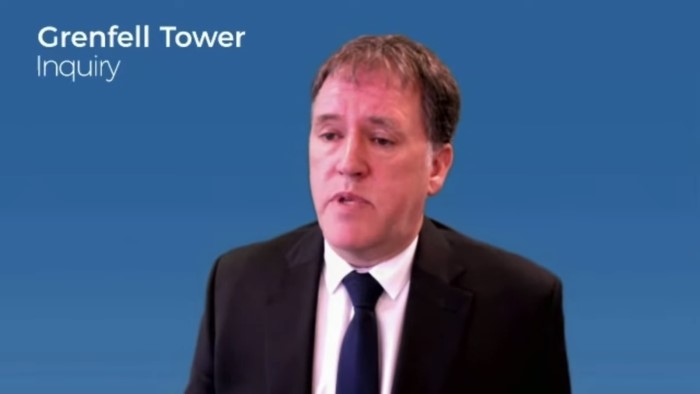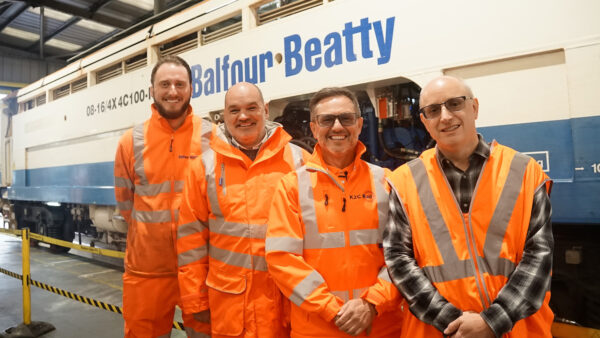
A former BRE manager who oversaw the BS 8414-1 test of Celotex’s RS5000 insulation product, used in the refurbishment of Grenfell Tower, has denied knowing about the addition of 6mm magnesium oxide board to help the system — which had previously failed — achieve a pass.
In November 2020, former Celotex product manager Jonathan Roper told the Grenfell Tower Inquiry that having failed the test in February 2014, its rig used in a follow-up test in May 2014 had been “over-engineered” to achieve a pass.
The reconstructed rig employed a system that at certain levels (adjacent to the Lamatherm fire barrier and at the top of the rig) used an 8mm Marley Eternit cladding panel, immediately behind which was a 6mm magnesium oxide board. 12mm Marley Eternit cladding panels were used on the remainder of the rig.
Giving evidence to the Inquiry yesterday (23 February), Phil Clark, who had a part-time role as manager of the BRE’s burn hall, overseeing cladding fire tests, was asked about his involvement in the Celotex tests in 2014.
BRE video footage from the failed February 2014 test — the first time the RS5000 had been subjected to such a test — recorded Clark telling Celotex employees that he had “seen worse”. He also agreed with lead counsel to the Inquiry Richard Millett that he told Celotex that the cause of the failure was the rainscreen boards opening up, deforming and falling away.
But he denied that he offered Celotex any advice on how to get its system to pass. He said: “I wouldn’t class it as guidance. It’s imparting a degree of information to the client which doesn’t give away other people’s IP, doesn’t tell them what to do, but…they need to understand how their system is performing.”
Millett then read out part of a statement given by Roper to the Inquiry, which related his version of events after the failed February 2014 test. Roper said: “Phil [Clark] said that he had ’seen worse fails ’ and suggested that Celotex might want to strengthen the outside of the test rig in order to counteract the cracking of the Marley Eternit panels. I told Phil that the Marley Eternit panels were also available in 12mm (in addition to the 8mm panels used in the test) and Phil responded that he thought that thickening the panels to 12mm might suffice. Phil also joked that Celotex could use a 6mm cement particle board like Kingspan − but I knew that this was not what the business wanted.”
Clark said he did not recall the conversation and he “definitely did not” remember joking about Kingspan’s use of a 6mm cement particle board. He later added: “It’s very unlikely that I would ever have joked about another client’s work in that way. It’s not what I do…So I would wholeheartedly say I didn’t say that.”
Celotex’s second test
Celotex commissioned a second test at a cost of £2,500 excluding VAT that was undertaken on 2 May 2014, which saw its system pass.
Clark was the project officer in charge of the May 2014 test, while contractor Simco constructed the rig. No updated drawings were prepared by Celotex in advance of the May test.
Roper stated in his evidence that prior to the second test, he sought advice from BRE. He said: “I spoke to Phil about thickening the cladding panel to 12mm. I believe we also spoke about the option of strengthening the fire barrier level with a two-panel solution because it appeared from the February test that the cladding panel had cracked and fallen away, which enabled the fire to jump around the barrier at level 2. I do not think that Phil suggested anything specific in this regard.”
Clark said he did not agree with Roper’s statement. He said: “To the best of my recollection, I have never had a conversation along the lines he’s suggested there… I would say he was lying.”
In his statement given prior to the hearing, Clark said no additional materials were delivered to the BRE between the two tests apart from a new supply of rainscreen cladding board. But subsequent questions from Millett revealed that several other materials ordered by Celotex for the new system were delivered to BRE. Clark agreed that it wasn’t the case that the May test was done “on a rig comprised solely of materials left over from the February test”.
Millett also asked why there was no evidence that 6mm magnesium oxide board that Celotex used to pass the test, which had been ordered by Roper with instructions that it be sent to BRE, had been delivered to the BRE.
Clark suggested that a security guard could have signed for the delivery and that the delivery form could have been lost.
Millett asked: “Does that mean that when you conducted a test, you weren’t always absolutely sure what the precise make-up and composition of the rig you were testing was?”
Clark said: “I wouldn’t say necessarily, no, but if you’ve got somebody who’s going out of their way to deceive, then there was a possibility they could do that, if that was their intention.”
Millett asked: “Can you explain, then, why it was that Mr Roper, if he was setting out to sneak the 6mm magnesium oxide past the BRE without them noticing them, asked Euroform to deliver it to the BRE?”
Clark replied: “No.”
Presence of 6mm magnesium oxide board
Clark said he did not see any updated or revised drawings ahead of the May 2014 test but this did not strike him as strange “because to all intents and purposes they were repeating the same test…the only different was the changed outer sheet”.
“My understanding was it was an exact repeat except for the change of one item, which was the external rainscreen board and everything else was exactly the same,” he said.
Attempting to explain why he “missed” the presence of a layer of magnesium oxide board at the second-level thermocouples and at the top of the rig, Clark said: “No, I can’t, and this is what has been playing in my mind for a long time… To a certain extent, we relied on the client delivering what they said they were going to deliver… I still can’t think why I missed it.”
He suggested that his absence from the office for two days during the rig’s construction, attending a first aid course, could have accounted for why he was not aware of the magnesium oxide board.
He also said that the only photos he had seen of the rig were taken prior to the external cladding being applied to the rig. During the hearing, Millett showed Clark photos that appeared to show the layer of magnesium oxide board but Clark said they were the first time he had seen them.
Millett said: “One possibility, Mr Clark, is that you didn’t miss it, and what Mr Hayes and Mr Roper have told the Inquiry on oath is correct and that you knew it was there.”
Clark said: “No, I didn’t know it was there, no.”
The Inquiry continues.











